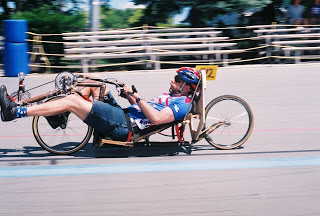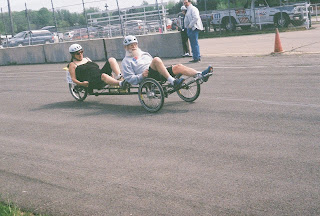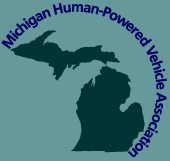SEAN COSTIN completed the fairing last year, which fits over the NoCom carbon fiber low racer he raced previously. The forward holes provide clearance for his knees; one knee can be seen protruding in the above photo. The chainring that can be seen in the photo below is 104 teeth, which is "way too big a gear," Sean said.
Words and photos by Mike Eliasohn
The 29th annual Michigan HPV
Rally May 18-19 attracted 38 riders and 29 vehicles (if my counting
is correct) to the Waterford Hills sports car racing track in Clarkston.
Of those, five vehicles and seven
riders came from the University of Toronto – back for the fourth straight year – and three vehicles and riders from “Team
Kowalik.”
THE KOWALIK KIDS line up for the start of the 25-lap road race on Sunday morning. From left are Genevieve, 8 (held by Sean Costin), Cecilia, 10, and Florian, 14 (both held by their father, Fran).
Fran Kowalik from Deerfield, Ill.,
brought three of his kids, who composed the entire junior class.
Genevieve, 8, probably our youngest competitor ever, was riding a
vintage upright Gitane 3-speed; Cecilia, 10, was on an Earth Cycles
Sunset low racer; and Florian, 14, was on an M5 low racer.
DOUG GROSSJEAN, who does not own a car, pedaled his Lightning F40 from his home in Dearborn 35 miles to the track on Friday, camped overnight, competed Saturday and then pedaled home.
As usual, the stock class drew the
most entries, 13. The top three were Dennis Grelk, Donnellson,
Iowa, on his homebuilt low racer, 330 points; 2) Warren Beauchamp, Elgin, Ill., NoCom low racer, 317; and 3) newcomer Eric Winn, Brighton,
on his front-wheel drive, front-wheels steering (moving bottom
bracket) Cruzbike Vendetta, 274.
ERIC WINN of Brighton competed for the first time at the Michigan HPV Rally with his new CruzBike Vendetta and finished third in the stock class.
The top three in the remaining classes
were:
Streamliners (7 vehicles)– 1) Dennis
Grelk, Barracuda (built by Warren Beauchamp), 304 points; 2) Cameron
Robertson, U-T Vortex, 285; and 3) Dan Glatch, Franklin, Wis., Milwaukee
Flyer (built by Wimpe van der Merwe of South Africa, who brought it to the U.S. in 1993), 220.
Streetliner (4) – 1) Rich Myers, Xenia, Ohio, "Chiquita Banana" (it's yellow), 335; 2) Bob Krezewinski, Ypsilanti, F40,
170; and 3) newcomer Doug Grossjean, 165. Doug, who doesn't own a
car, rode his F40 35 miles from Dearborn on Friday, camped overnight
at the track, and then pedaled it home Saturday afternoon, The 35
miles Friday took him about two hours. Bob K. also competed only on
Saturday. Mention should also be made of fourth place finisher Andrew
Gierz, who brought the Ferris State University HPV team's enclosed
tricycle, which competed a few weeks earlier in the American Society
of Mechanical Engineers student HPV competition, which Ferris hosted.
(See article below). He also only competed on Saturday, and left with
140 points.
Women – Dora Cortez of Chicago, on
her Rick Gritters-built low racer, was the only competitor, 300 points.
Tricycles (7 vehicles) – 1) Brian Stevens, Grand Rapids, Catrike 700; 330; 2) Jeff Hunn, North Manchester, Ind., Black Max leaning trike built by Tim Hicks of Barrie, Ont., 315 points, and 3) Dennis Grelk
on his front-wheel-drive low racer, fitted with his tilting
two-wheels-in-the-rear conversion, 295.
Junior – 1) Cecilia Kowalik, 340; 2)
Genevieve Kowaki, 310; and 3) Florian Kowalik, who experienced two
flat tires during the competition, 290.
Tandem – Three teams competed, all
married couples: 1) Chris and Dora Cortez, Chicago, on an upright
Cannondale, 360; 2) Tedd and Donna Wheeler, Reed City, BikeE E2 they
bought from Bruce Gordon, 320; and 3) Bruce and Linda Gordon, Organic
Engines Troika tricycle, 310.
CHRIS AND DORA CORTEZ from Chicago, shown here getting underway in the standing start half-mile on Saturday won the tandem class over two other married couples. Chris also competed in the stock and tricycle classes and Dora was the lone entrant in the women's class.
There was no urban transportation contest this year because Paul Pancella, who runs it, was unable to attend.
Following are the top two in each
class in each event. Complete results are available at
recumbents.com/wisil/hpra.htm, then click on "racing results and pictures."
Saturday
One-hour time trial:
Streamliner – 1) Dennis Grelk, 23 laps at average speed of 31.56
mph; 2) Dave Johnson, Olivet, Great
White, 20 laps at 27.24 mph. Streetliner – 1) Doug Grossjean, 16
laps at 21.27 mph; 2) Bob Krezewinski , 15 laps at 20.21 mph. Stock
– 1) Warren Beauchamp, 18 laps at 25.12 mph; 2) Dennis Grelk, 18
laps at 23.80 mph. Women – 1) Dora Cortez, 11 laps at 13.85 mph.
Tricycle – Jeff Hunn, 15 laps at 19.85 mph; 2) Brian Stevens, 13
laps at 17.90 mph. Junior – 1) Florian Kowalik, 15 laps at 20.301
mph; 2) Cecilia Kowalik, 11 laps at 14.92 mph. Tandem – 1) Chris and Dora
Cortez, 13 laps at 16.71 mph; 2) Tedd and Donna Wheeler, 11 laps at
14.95 mph.
DENNIS GRELK of Donnellson, Iowa, won the streamliner class in his Barracuda, built many years ago by Warren Beauchamp. He also won the stock class on the low racer he built and, fitted with his two-wheels-in-the-rear conversion, finished third in the tricycle class.
Hill climb: Streamliner –
1) Cameron Robertson, 25.06 sec., 2) Alfie Tham, Univ. of Toronto
Celero tricycle, 25.68 sec. Streetliner – 1) Bob Krezewinski, 24.81
sec., 2) Doug Grossjean, 27.46 sec. Stock – 1) Warren Beauchamp,
21.89 sec. 2) Jim Iwaskow, Richmond Hill, Ont., Challenge Jester, 23.50 sec.
Women – 1) Dora Cortez, 33.59 sec. Tricycle – 1) Brian Stevens,
24.31 sec., 2) Dennis Grelk, 26.59 sec. Junior – 1) Florian
Kowalik, 21.87 sec. (quickest time of all competitors), 2) Cecelia
Kowalik, 37.12 sec. Tandem – 1) Chris and Dora Cortez, 29.72 sec.,
2) Bruce and Linda Gordon, 35.72 sec.
DAN GLATCH of Franklin, Wis., finished third in the streamliner class in the Milwaukee Flyer. The front-wheel-driver liner was built by Wimpe van der Merwe of South Africa, who brought it to the U.S. in 1993 to compete in the International Human Powered Speed Championships.
Coast down (combined with
the hill climb; when riders reach the top of the hill, they stop
pedaling and then coast): Streamliners – 1) Cameron Robertson, 2)
Sean Costin, Arlington Heights, Ill., The Swift. Streetliner – 1) Rich
Myers, 2) Bob Krezewinki. Stock – 1) Dennis Grelk, 2) Warren
Beauchamp. Women – 1) Dora Cortez. Tricycle – 1) Dennis Grelk, 2)
Brian Stevens. Junior – 1) Florian Kowalik, 2) Cecilia Kowalik.
Tandem – 1) Chris and Dora Cortez, 2) Bruce and Linda Gordon.
Standing start half-mile
time trial: Streamliner – 1) Cameron Robertson, 1:01.5 min., 2)
Trefor Evans, Unv. of Toronto Vortex, 1:07.3 min. Streetliner – 1)
Rich Myers (only competitor), 1:26.4 min. Stock – 1) Mike Mowett,
St. Clair Shores, Morciglio M1 low racer, 1:07.2 min., 2) Dennis
Grelk, 1:10.4 min. Women – 1) Dora Cortez, 1:28.5 min. Tricycle –
1) Dennis Grelk, 1:15.7 min.; 2) Jeff Hunn, 1:21.0 min. Junior – 1)
Cecelia Kowalik, 1:39.4 min., 2) Genevieve Kowalki, 2:02.1 min.
Tandem – Chris and Dora Cortez, 1:29.7 min., 2) Tedd and Donna
Wheeler, 1:40.3 min.
FIVE UNIVERSITY of TORONTO students took turns racing their sleek new Celero trike during the weekend. Interior view, showing the monocoque construction, is below.
Sunday
200 foot sprints:
Streamliner – 1) Trefor Evans, Univ. of Toronto Vortex, 46.97 mph;
2) Cameron Robertson, Vortex, 46.46 mph. Streetliner – 1) Rich
Myers (only competitor), 32.94 mph. Stock – 1) Mike Mowett, 39.73
mph; 2) Dennis Grelk, 33.37 mph. Women – 1) Dora Cortez, 28.46 mph.
Tricycle – 1) Dennis Grelk, 31.92 mph, 2) Brian Stevens, 31.12 mph.
Junior – 1) Florian Kowalik, 33.50 mph; 2) Cecelia Kowalik, 20.48
mph. Tandem – 1) Chris and Dora Cortez, 27.83 mph, 2) Tedd and
Donna Wheeler, 27.19 mph.
Tricycle race: After the sprints and before the start of the road races, the four tricyclists conducted their own race in the parking/pit area. Times were not recorded, only finishing order: 1) Dennis Grelk, 2) Brian Stevens, 3) Jeff Hunn, 4) Chris Cortez.
25-lap road races (two races were conducted around the .431 mile course, which did
not include the hill): Streamliner – 1) Dennis Grelk, 24.41 min.,
26.19 mph average speed, 2) Sean Costin, 24.85 mph. Streetliner –
1) Rich Myers , 19.86 mph. Stock – 1) Dennis Grelk, 24.91 mph, 2)
Mike Mowett, 24.57 mph. Women – no competitors. Tricycle – 1)
Trefor Evans, 23.99 mph, 2) Jeff Hunn, 19.90 mph. Junior – 1)
Cecilia Kowalik, 14.80 mph, 2) Genevieve Kowalik, 13.81 mph. Tandem –
Chris and Dora Cortez, 16.56 mph, 2) Tedd and Donna Wheeler, 14.88
mph.
JEFF HUNN, waiting for the start of the standing-start half-mile, raced a Black Max front-wheel drive leaning tricycle built by Tim Hicks of Barrie, Ont. Jeff, from North Manchester, Ind., finished second in the tricycle class. The leaning mechanism is show below. For more on Black Max and other HPVs built by Tim, go to www.fleettrikes.com.
TEDD and DONNA WHEELER of Reed City finished second in the tandem class on their BikeE E2 they bought from Bruce Gordon. Tedd also competed in the stock class on his Rick Gritters-built low racer, finishing ninth.
BRUCE and LINDA GORDON of Buchanan finished third in the tandem class on their Organic Engines Troika trike.














































